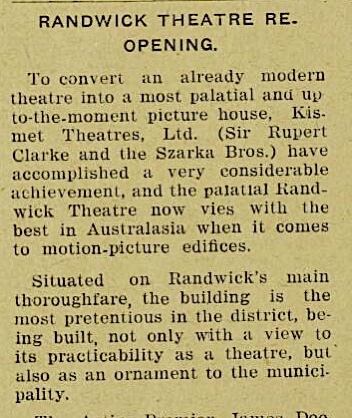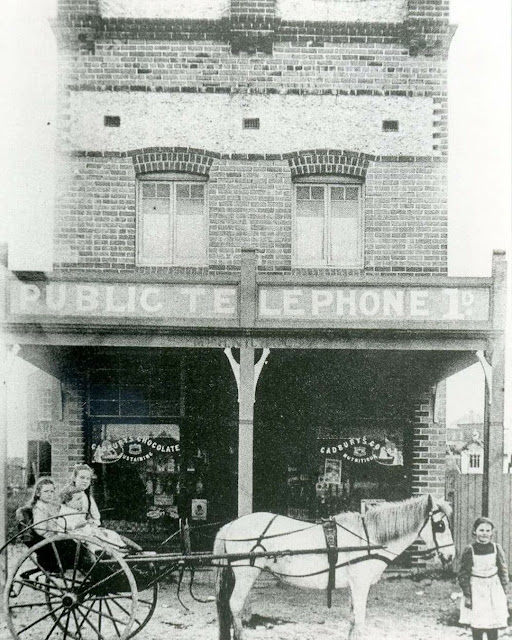 |
| Parliament House, Sydney: The Oldest Public building in the City of Sydney. |
In December 1792, Governor Phillip proclaimed the open space which became the Botanic Gardens, Domain, Hyde Park and Macquarie Street for government use.
The oldest part of Parliament House was
built first as the north wing of Governor Macquarie's "Rum Hospital".
Macquarie Street was proclaimed in 1810 by Governor Macquarie.
The “Rum Hospital” is within the walls of NSW Parliament House, opened in 1816.
Governor Lachlan Macquarie was determined to build a
town, but without funds, he allowed the building contractors to import and sell 60,000 gallons of rum to fund the project.
The NSW Legislative Council had been without a permanent seat since its formation in 1824, and this situation would remain until 1856 when the Council moved into the incomplete building.
 |
| Don Dorrigo Gazette and Guy Fawkes Advocate (NSW : 1910 - 1954), Saturday 30 August 1924, |
The Iron Church mentioned above was one of a pair completed by Roberston and Lister of Glasgow in 1854 and shipped to Australia.
The church sat next to Parliament House for 50 years until another church was built in Phillip Street. The church was then used as a clothing factory and afterwards, the Free Public Library in 1881.
In 1868, the Nightingale Wing was completed. Henry Parkes ("the Father of Federation") had been in correspondence with Florence Nightingale, and the then Government decided to build the Nightingale Wing at the Sydney Hospital on plans
approved by Miss Nightingale.
 |
| Nightingale Wing at the Sydney Infirmary on Macquarie St, Sydney in the early 1870s. Mitchell Library, State Library of NSW |
In 1890 the Free Public Library moved to the Queen Victoria Markets and the church was he grounds of the Lidcombe State Hospital. later, the church was either demolished or moved elsewhere.
 |
| Sydney Morning Herald (NSW : 1842 - 1954), Saturday 3 November 1906 |
The original hospital had a large central building and two smaller wings. The central building was demolished and replaced in 1894 by the Sydney Hospital, but the two smaller wings remain.
A new chamber was added to the north of the building after 1843, but when a fire broke in 1933, curious markings of letters and figures were found on the boards, which were thought to be piano packing cases used with a lot of other junk in the erection of the room. (1.)
There have been many additions and extensions to the Parliament buildings. And also, various redesign, proposals and plans to demolish and remove the building.
The colour used in the Chamber follows the British tradition of green for the Lower House, and red for the Upper House.
 |
| Balcony, Parliament House, Sydney, NSW, 1871, SLNSW |
The Speaker's Chair was hand carved by a Member of the Assembly, Ninian Melville, in 1886.
 |
| HOUSES OF PARLIAMENT, SYDNEY.Australasian (Melbourne, Vic. : 1864 - 1946), Saturday 5 October 1895 |
 |
| Group on Bowling Green, Parliament House, Sydney.Sydney Mail and New South Wales Advertiser (NSW : 1871 - 1912), Saturday 1 February 1902 (see here) |
 |
| Mitchell Library and Macquarie St from Public Library, Sydney NSW, 1919, Museums of History NSW - State Archives Collection |
 |
| Macquarie Street Sydney, NSW, circa 1900-1919, Sydney City Council |
 |
| Opening of tiie N.S.W. Parliament on June 36. Arrival of the Governor, Sir Harry Rawson, at Parliament House. Australian Town and Country Journal (Sydney, NSW : 1870 - 1919), Wednesday 4 July 1906 |
 |
| N.S.W. PARLIAMENT. New South Wales srato Parliament was opened on September 9 by His Excellency the Governor, Australasian (Melbourne, Vic. : 1864 - 1946), Saturday 19 October 1907 |
 |
| Soldiers ride along Macquarie Street during peace celebrations, Sydney, 19 July 1919, Fairfax archive |
 |
| Macquarie Street with Sydney Hospital, Parliament House and Burdekin House in view, Sydney, ca. 1925 , NLAUST |
1, AS FAR BACK AS 1909 this plan was prepared of a building which would adequately fit
the importance of a home for the State Parliament. Eighteen years have elapsed, and still
nothing has been done to replace the existing eyesore in Macquarie Street. 2. THE PILE WHICH IS CALLED PARLIAMENT.— For years this ugly block of buildings' has served New South Wales, the principal State in the Commonwealth, for a House of Parliament. Just now' there is a recurrence of the clamor for a structure more befitting the purpose of the institution.Daily Telegraph (Sydney, NSW : 1883 - 1930), Monday 11 July 1927
 |
| "Terraced housing opposite Sydney Hospital, Macquarie Street, Sydney, 1933 (City of Sydney Archives, A-00006473)" |
 |
| Wore "Slacks" to Parliament Miss Sylvia Kellaway, the first woman to wear slacks" in the State Parliament House, Sydney, arriving at the House,Courier-Mail (Brisbane, Qld. : 1933 - 1954), Tuesday 28 November 1933 |
 |
| DH 88 Comet "Grosvenor House" G-ACSS moved into Martin Place to a spot near the Sun-Telegraph Building, Elizabeth Street, for public display (adults 1s, children 3d), 1934, State Library of New South Wales |
 |
| Parliament House from Macquarie Street, Sydney, 1952, SLNSW |
 |
| THE I'lRST TIME IN HISTORY, the Queen yesterday opened an Australian Parliament. She is shown here in the New South Wales Legislative Council Chamber for the opening of the State Parliament . The Duke of Edinburgh is on the. ' right.Age (Melbourne, Vic. : 1854 - 1954), Friday 5 February 1954 |
 |
| View south from near Hunter Street along Macquarie Street towards Martin Place and Hyde Park showing the Parliament House buildings, Sydney Hospital, parked vehicles and pedestrians. 1957. Sydney City Council |
Around NSW Parliament House |
| The Parliament House in Sydney, NSW, is a heritage-listed complex of buildings |
 |
| The Legislative Council has met within the parliamentary precinct since 1828 and the current Chamber has been in use since 1856. The Legislative Assembly chamber is green, which follows the British tradition for lower houses |
 |
| The Legislative Council chamber is furnished in red, which follows the British tradition for the upper house. Parliament NSW. The New South Wales Legislative Council, often referred to as the upper house, is one of the two chambers of the parliament of the Australian state of New South Wales |
 |
| Parliament House, Sydney: The Oldest Public building in the City of Sydney |
 |
| The Jubilee Library opened in 1906 and was named in commemoration of 50 years of responsible government, Parliament NSW. Designed by Government Architect Walter Liberty Vernon |
 |
| Parliament House, Sydney: The Oldest Public building in the City of Sydney |
 |
| Parliament House, Sydney, NSW, 2022 |
Places To Go
Parliament House is open weekdays to allow people to see the workings of government in the beautiful heritage chambers.
Lucy Osburn-nightingale museum -the history of nursing and medicine in Australia from the arrival of the first fleet in 1788.
A WALKING TOUR THROUGH MACQUARIE ST

























































